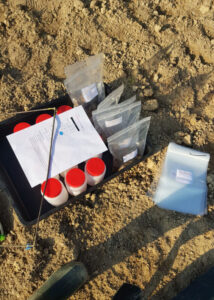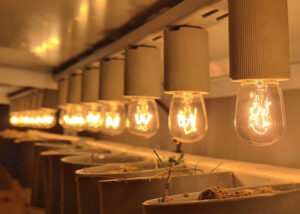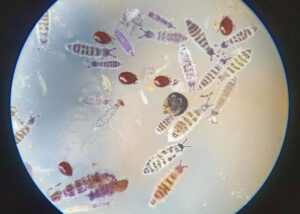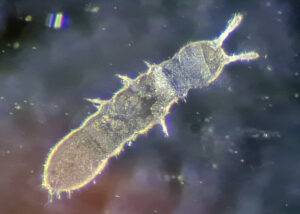[et_pb_section fb_built=”1″ admin_label=”section” _builder_version=”3.22″ global_colors_info=”{}”][et_pb_row column_structure=”1_2,1_2″ admin_label=”row” _builder_version=”3.25″ background_size=”initial” background_position=”top_left” background_repeat=”repeat” global_colors_info=”{}”][et_pb_column type=”1_2″ _builder_version=”3.25″ custom_padding=”|||” global_colors_info=”{}” custom_padding__hover=”|||”][et_pb_text _builder_version=”4.10.8″ _module_preset=”default” global_colors_info=”{}”]
Our ecotoxicology teams in France are now in full swing extracting microarthropods from soil microfauna field studies. Trials were started in early Spring and we are now engaged in the 6-month assessments.
Soil-dwelling mites, collembola and other soil microarthropods play an important role in litter decomposition. In-crop and off-crop field studies on natural populations evaluate the effects of plant protection products on these non-target arthropods.
Soil core samples are made at 1, 3, 6 and 12 months after application. Microarthropods are extracted from the soil in Berlese (Tulgren) funnel apparatus. This involves a desiccation gradient; mobile organisms move from the dry environment and fall into collecting vessels for counting and species identification. Soil microarthropod field studies are usually combined with earthworm field studies.
This it is the right time to book study slots for soil organism testing or any other higher tier testing needs in Spring 2022; contact eythier@syntechresearch.com for more information on:
- Honey bee brood semi-field and field studies (treated crop or feeding exposure)
- Solitary bee and bumble bee semi-field and field studies
- Pollinator residues studies (pollen, nectar, honey and other bee matrices)
- NTA aged residue and semi-field studies – NTA in-crop and off-crop field studies
- Predatory mite field studies
- Residue studies in arthropods
- Earthworm field studies
- Soil microfauna field studies
- Residue studies in soil organisms
- Monitoring studies on pollinators, arthropods and soil organisms
[/et_pb_text][/et_pb_column][et_pb_column type=”1_2″ _builder_version=”3.25″ custom_padding=”|||” global_colors_info=”{}” custom_padding__hover=”|||”][et_pb_blurb _builder_version=”4.10.8″ _module_preset=”default” global_colors_info=”{}”]





